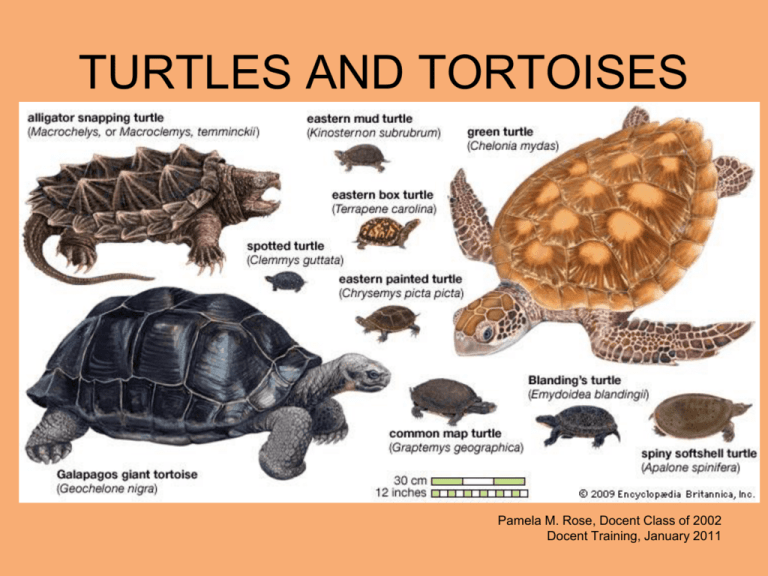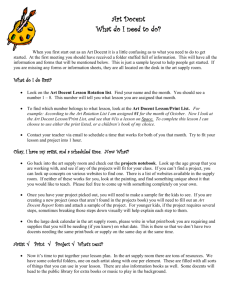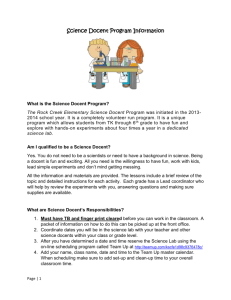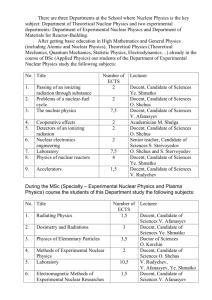Turtles and Tortoises - a powerpoint presentation for
advertisement

TURTLES AND TORTOISES Pamela M. Rose, Docent Class of 2002 Docent Training, January 2011 TURTLES AND TORTOISES are REPTILES Pamela M. Rose, Docent Class of 2002 Docent Training, January 2011 TURTLES AND TORTOISES What does that mean? Pamela M. Rose, Docent Class of 2002 Docent Training, January 2011 TURTLES AND TORTOISES Ectothermic, oviparous, “scales” – in this case, a protective shell Pamela M. Rose, Docent Class of 2002 Docent Training, January 2011 TURTLES AND TORTOISES Basically lizards with a suit of armor Pamela M. Rose, Docent Class of 2002 Docent Training, January 2011 TURTLES AND TORTOISES Can you identify these specimens? Pamela M. Rose, Docent Class of 2002 Docent Training, January 2011 TURTLES AND TORTOISES South American Red footed tortoise Can you identify these specimens? Pamela M. Rose, Docent Class of 2002 Docent Training, January 2011 TURTLES AND TORTOISES South American Red footed tortoise – located in our Reptile House and… Can you identify these specimens? Pamela M. Rose, Docent Class of 2002 Docent Training, January 2011 TURTLES AND TORTOISES South American Red footed tortoise – located in our Reptile House and… in the Education Dept. = Jabuti Can you identify these specimens? Pamela M. Rose, Docent Class of 2002 Docent Training, January 2011 TURTLES AND TORTOISES Eastern box turtle Can you identify these specimens? Pamela M. Rose, Docent Class of 2002 Docent Training, January 2011 TURTLES AND TORTOISES Eastern box turtle – Located in… ??? Can you identify these specimens? Pamela M. Rose, Docent Class of 2002 Docent Training, January 2011 TURTLES AND TORTOISES Eastern box turtle – Located in… Education Dept. = Timmy Can you identify these specimens? Pamela M. Rose, Docent Class of 2002 Docent Training, January 2011 TURTLES AND TORTOISES Eastern box turtle – Located in… Education Dept. = Timmy Are there other box turtles at the Zoo? Can you identify these specimens? Pamela M. Rose, Docent Class of 2002 Docent Training, January 2011 TURTLES AND TORTOISES Eastern box turtle – Located in… Education Dept. = Timmy Are there other box turtles at the Zoo? YES! Indochinese box turtle in the Reptile House Can you identify these specimens? Pamela M. Rose, Docent Class of 2002 Docent Training, January 2011 TURTLES AND TORTOISES African Pancake tortoise Can you identify these specimens? Pamela M. Rose, Docent Class of 2002 Docent Training, January 2011 TURTLES AND TORTOISES African Pancake tortoise – located in… ?? Can you identify these specimens? Pamela M. Rose, Docent Class of 2002 Docent Training, January 2011 TURTLES AND TORTOISES African Pancake tortoise – located in… Reptile House Can you identify these specimens? Pamela M. Rose, Docent Class of 2002 Docent Training, January 2011 TURTLES AND TORTOISES What is the signature feature of this particular tortoise? African Pancake tortoise – located in… Reptile House Can you identify these specimens? Pamela M. Rose, Docent Class of 2002 Docent Training, January 2011 TURTLES AND TORTOISES What is the signature feature of this particular tortoise? Shell is flattened due to ability to squeeze itself into small openings to escape predators African Pancake tortoise – located in… Reptile House Can you identify these specimens? Pamela M. Rose, Docent Class of 2002 Docent Training, January 2011 TURTLES AND TORTOISES What is the signature feature of this particular tortoise? Shell is flattened due to ability to squeeze itself into small openings to escape predators – thus we cannot say that ALL tortoises have rounded shells = always exceptions in the animal kingdom African Pancake tortoise – located in… Reptile House Can you identify these specimens? Pamela M. Rose, Docent Class of 2002 Docent Training, January 2011 TURTLES AND TORTOISES North American spotted turtle Clemmys guttata Can you identify these specimens? Pamela M. Rose, Docent Class of 2002 Docent Training, January 2011 TURTLES AND TORTOISES North American spotted turtle Clemmys guttata Located in… ??? Can you identify these specimens? Pamela M. Rose, Docent Class of 2002 Docent Training, January 2011 TURTLES AND TORTOISES North American spotted turtle Clemmys guttata Located in… Reptile House and Education Dept. = Clemm Can you identify these specimens? Pamela M. Rose, Docent Class of 2002 Docent Training, January 2011 What is the difference between a turtle, a tortoise and a terrapin? Red-eared slider turtles Galapagos tortoise Diamondback terrapin Pamela M. Rose, Docent Class of 2002 Docent Training, January 2011 What is a Chelonian? Pamela M. Rose, Docent Class of 2002 Docent Training, January 2011 In general, Chelonian is a good scientific umbrella term = order Chelonia, from the Greek word for tortoise Pamela M. Rose, Docent Class of 2002 Docent Training, January 2011 Terminology differs depending on endemic area of the world in which species reside Pamela M. Rose, Docent Class of 2002 Docent Training, January 2011 For example, in Australia, only sea turtles are called “turtles” – all others are “tortoises” Pamela M. Rose, Docent Class of 2002 Docent Training, January 2011 Turtles Spend most of their life in water Hard shells (are their exceptions… ???) Pamela M. Rose, Docent Class of 2002 Docent Training, January 2011 Turtles (cont.) Spend most of their life in water Hard shells (are their exceptions… ???) YES – soft-shelled turtles have fewer bones, cartilaginous plastron and a leathery covering Pamela M. Rose, Docent Class of 2002 Docent Training, January 2011 Turtles (cont.) Spend most of their life in water Hard shells (are their exceptions… YES – soft-shelled turtles have fewer bones, cartilaginous plastron and a leathery covering) Varying degrees of webbing on feet Flattened legs for swimming Live in fresh water (ponds and lakes) and the sea Climb out onto banks, logs, or rocks to bask in the sun. Burrow into the mud in cold weather - go into torpor until spring Sea turtles especially adapted with long feet that form flippers and a streamlined body shape – exit water only to lay eggs Pamela M. Rose, Docent Class of 2002 Docent Training, January 2011 Turtles (cont.) Straight necks - Cryptodira - all North American turtles Side necks - Pleurodira - refers to the way the turtle withdraws its neck into its shell (they curve neck around and tuck it along the side) Lifespan slow growth pattern, mature at 5-7 years depending on species, 25-50 years (red-eared sliders commonly 40, some Eastern box turtles alleged to make it to 100) Pamela M. Rose, Docent Class of 2002 Docent Training, January 2011 Tortoises Live on land Rounded or domed shells rather than shells streamlined for water (are there exceptions? – remember our Pancake tortoise) Eat low-growing shrubs, grasses, and even cactus Elephantine hind legs, shovel-like forelegs for digging Lifespan Some species live 200+ years Red-footed tortoise 50-60 years Largest tortoise: Galapagos >500 lbs. Smallest tortoise: Speckled Cape Padloper < 3” Pamela M. Rose, Docent Class of 2002 Docent Training, January 2011 Terrapins Spend time in water and on land Inhabit brackish, swampy areas in eastern and southern U.S. coast Term not commonly used except for this particular species Malaclemys terrapin terrapin (for you taxonomists) Diamonback terrapin is the official reptile of what state? Pamela M. Rose, Docent Class of 2002 Docent Training, January 2011 Terrapins (cont.) Spend time in water and on land Inhabit brackish, swampy areas in eastern and southern U.S. coast Term not commonly used except for this particular species Malaclemys terrapin terrapin (for you taxonomists) Diamonback terrapin is the official reptile of what state? -- Maryland, also official mascot of U. of MD College Park; protected in MD IUCN NT=near threatened Check out http://www.terrapinconservation.org/ Pamela M. Rose, Docent Class of 2002 Docent Training, January 2011 Chelonian parts Plastron = lower/under shell Carapace = upper/top shell To which structure is the carapace attached? Pamela M. Rose, Docent Class of 2002 Docent Training, January 2011 Chelonian parts Plastron = lower/under shell Carapace = upper/top shell To which structure is the carapace attached? RIGHT! The spine! Pamela M. Rose, Docent Class of 2002 Docent Training, January 2011 Evolution Cretaceous – 144-65 million years ago Jurassic – 206-144 million years ago Triassic – 248-206 million years ago Oldest known turtles from late Triassic: Odontochelys (only carapace and had teeth) and – within just 10 million years – Proganochelys (carapace and plastron, vestigial teeth, spiked neck and tail, could not retract head) Permian – 290-248 million years ago Ancestors of first turtles (possibly Owenetta) living in Oklahoma Pamela M. Rose, Docent Class of 2002 Docent Training, January 2011 Development and Function Ribs are immovable, so unable to breathe like other reptiles or mammals. Instead, abdominal muscles perform the function of the ribs: two muscles enlarge the chest cavity to breathe in, and others press the organs against the lungs to force the air out. Tortoise carapace hardens about 3 years after hatching Eastern box plastron hinge firms up 2-6 years (Eastern box) Pamela M. Rose, Docent Class of 2002 Docent Training, January 2011 Development and Function (cont.) As the shell (made from keratin) grows, the number of scutes remains the same, but each becomes larger. In some turtles, old scutes are shed and replaced by larger, new ones. In other species, including box turtles, tortoises, and wood turtles, scutes enlarge in diameter as new keratin is laid down. Scutes that cover both halves of the shell are grouped and named - used in species recognition Pamela M. Rose, Docent Class of 2002 Docent Training, January 2011 Development and Function (cont.) Age estimation based on growth layers, however, can be erroneous for several reasons: Some turtles produce multiple growth zones per year. Growth is determined by stressors in the environment, so age determination by examination of growth rings would be less accurate in wild turtles, than those kept in environments which do not change significantly. Growth layers may wear with age, so older turtles may be estimated to be younger than they really are. Pamela M. Rose, Docent Class of 2002 Docent Training, January 2011 Development and Function (cont.) Shell is a marvelous product of evolution - collar bone and pelvis have been moved inside the rib cage which is then fused to the shell. Somehow the ancestral form managed this feat -- so successful that very few changes have been made to the basic turtle morphology in over 200 million years. Pamela M. Rose, Docent Class of 2002 Docent Training, January 2011 Development and Function (cont.) Turtle shells develop as embryonic ribs which eventually outgrow and enclose the shoulder and hip bones, forming the upper shell (carapace) and lower shell (plastron). The backbone fuses with the flattened ribs, forming a rigid bony case for the vital organs. Pamela M. Rose, Docent Class of 2002 Docent Training, January 2011 Development and Function (cont.) Legs have to be sturdy and dense for support so leg bones have little marrow for blood cell production Carapace has channels and spaces that produce red blood cells Pamela M. Rose, Docent Class of 2002 Docent Training, January 2011 Development and Function (cont.) Shells differ in protective ability: soft-shelled turtles including Leatherback sea turtles have a type of thick skin rather than hard shell. Box turtles hinges provide added protection to soft internal organs BUT may not be fully functional until about 6 years old. NOTE that mud and musk turtles have hinged plastrons, but they don’t fully close Pamela M. Rose, Docent Class of 2002 Docent Training, January 2011 Development and Function (cont.) Snapping Turtles! Not very well protected by their shells. The plastron in particular is tiny and doesn't begin to cover the animal. Compensate by fierce defense if threatened and ability to swing neck around greater than half-way back so, what does one NEVER do? Pamela M. Rose, Docent Class of 2002 Docent Training, January 2011 Development and Function (cont.) Snapping Turtles! Not very well protected by their shells. The plastron in particular is tiny and doesn't begin to cover the animal. Compensate by fierce defense if threatened and ability to swing neck around greater than half-way back so, what does one NEVER do? RIGHT! Never pick up a snapper with your hands, even toward the rear sides of the shell. Use a stick to help move off the road. Signature of a Snapping turtle is the V-shaped cuts in back of plastron. Pamela M. Rose, Docent Class of 2002 Docent Training, January 2011 Development and Function (cont.) Hearing: internal ear structures, although hearing isn't very important because their senses of vision and smell are excellent. Vision: seven types of cones for color reception give turtles the most complex cone system described for vertebrates. Many turtles have a horizontal black line running through their pupil that remains horizontal and parallel with the horizon even when the turtle is held vertically, suggesting that the line serves an optical purpose, perhaps to detect polarized light. Pamela M. Rose, Docent Class of 2002 Docent Training, January 2011 Other Turtles at the Zoo Yellow-spotted Amazon River Turtle Located in the Rainforest A type of side-necked turtle (waay cool!) – what term was that again? Pamela M. Rose, Docent Class of 2002 Docent Training, January 2011 Other Turtles at the Zoo Yellow-spotted Amazon River Turtle Located in the Rainforest A type of side-necked turtle (waay cool!) – what term was that again? RIGHT! Pleurodira CITES II designation Pamela M. Rose, Docent Class of 2002 Docent Training, January 2011 Other Turtles at the Zoo Giant South American River Turtle Located in the Rainforest These turtles engage in mutual grooming Sex of hatchlings determined by temperature of the nest Endangered and protected Pamela M. Rose, Docent Class of 2002 Docent Training, January 2011 Fun Facts! Largest turtle: Leatherback 95” head-tail Leatherbacks maintain core body temps higher than surrounding frigid water (30-40 degrees), disputing the “cold blooded” label. They primarily eat jellyfish -- esophagus has many backwards-pointing, stiff spines which aid in swallowing soft-bodied foods. Incapable of chewing hard prey due to their weak jaws. Largest tortoise: Galapagos >500 lbs. Located in the Rainforest No venomous or poisonous turtles (no teeth or venom sacs) Baby turtles tend to be carnivores, adults omnivores, most tortoises are herbivores (but NOTE: our Jabuti is sometimes offered pinkies!) Young Loggerhead Turtles have an amazing navigation system, involving detecting magnetic fields Stinkpot or Musk Turtle (Maine) lets off musky smell when disturbed Wood turtles, or “woodies" (Maine) thump the ground to make worms think it's raining so they come up, then get eaten Pamela M. Rose, Docent Class of 2002 Docent Training, January 2011 Fun Facts! Spotted turtle: Lifespan up to 30 years, mature at 8-10 years nest temperature dictates sex: cooler=more males spot distribution varies and changes with age sexually dimorphic: males elongated carapace and thicker, longer tail, dark jaws while females have yellowish color on jaws Special concern in NYS Habitat loss, sensitivity to pollution and toxins, and pet trade threats Clemm, 5 years old, is a “no touch” animal How did Clemm get is name? Clemmys guttata Pamela M. Rose, Docent Class of 2002 Docent Training, January 2011 Fun Facts! Red footed tortoise: Lifespan 50-60 years sexually dimorphic similar to Eastern box Used for food – in South America, tortoises are considered "fish" by the Catholic church and during holy week, redfoots are consumed in huge numbers During mating make a clucking sound like a hen “Jabuti” is the species name in Brazil Cites II Pamela M. Rose, Docent Class of 2002 Docent Training, January 2011 Fun Facts! Box Turtles: Shell so is so strong it can readily support weight 200 times greater than its own (this DOES NOT mean you can stand on Timmy!) slightly sexually dimorphic… males have longer, wider tails, more flattened shells, orange or red eyes, and a slightly concave plastron. Females have brown or light orange eyes and a very flat plastron. able to eat mushrooms which would make humans sick, and thus if humans eat box turtles they may become ill Females can store sperm up to 4 years, so can lay eggs for several seasons from one mating Even though turtles are considered aquatic as a group, box turtle feet are only slightly webbed, shell is more tortoise-like State reptile (and only land turtle) in North Carolina Lifespan 30-40 years in the wild, may live up to 100 in captivity: Timmy is 35 CITES II – threatened due to habitat loss and pet trade Pamela M. Rose, Docent Class of 2002 Docent Training, January 2011




